Domain Specific Embedded Languages
A common problem in software development
Reading: DSL for the Uninitiated by Debasish Ghosh
- Business users speak the domain terminology
- Stock market: bonds, stocks, options, etc.
- Cryptography: symmetric keys, asymmetric keys, games, perfect secrecy, chain blocked cypher, etc.
- Computer graphics: vectors, bézier curve, line, bézier spline, etc.
- Developers speak software language
- Data types
- Functions
- Modules
- Lazy evaluation
There is a semantic gap.
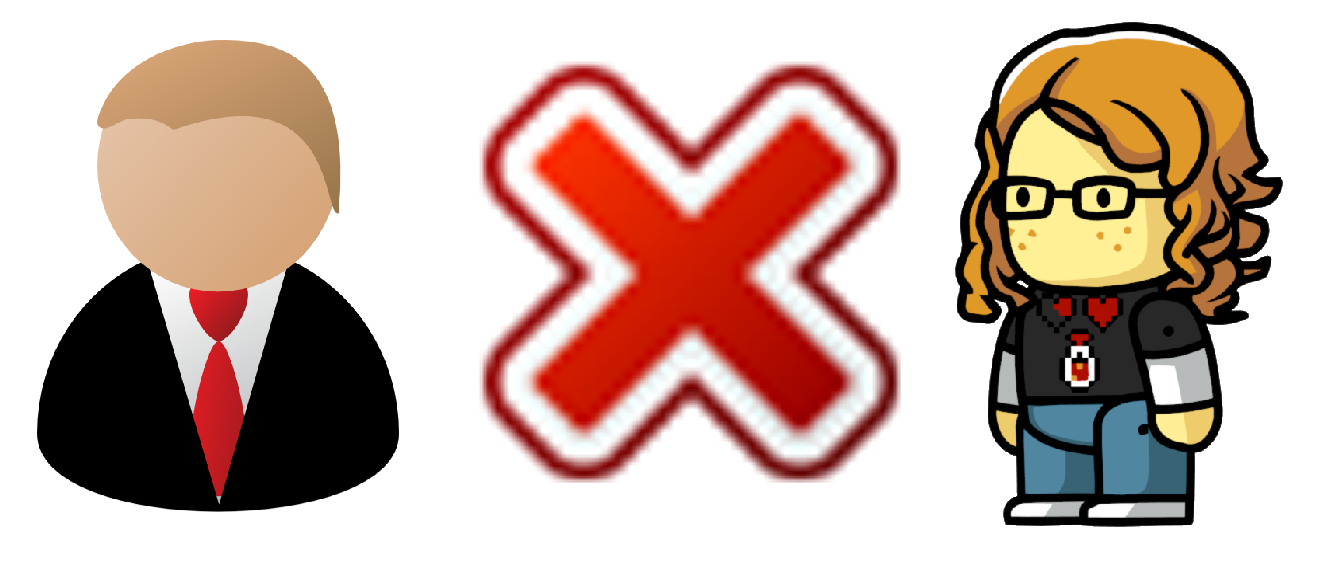
- How can we bridge the gap?
- Modeling the domain in software.
- In other words, we should aim to design a domain model in your software.
- How do we start? What if the domain is colossal?
- Identify minimum domain model elements.
- Propose constructs that glue together domain model elements and create other (possible more complex) ones.
- Define how minimum and glued elements behave in your software.
The domain model elements and the corresponding constructs are the common language between the developer and the business users.
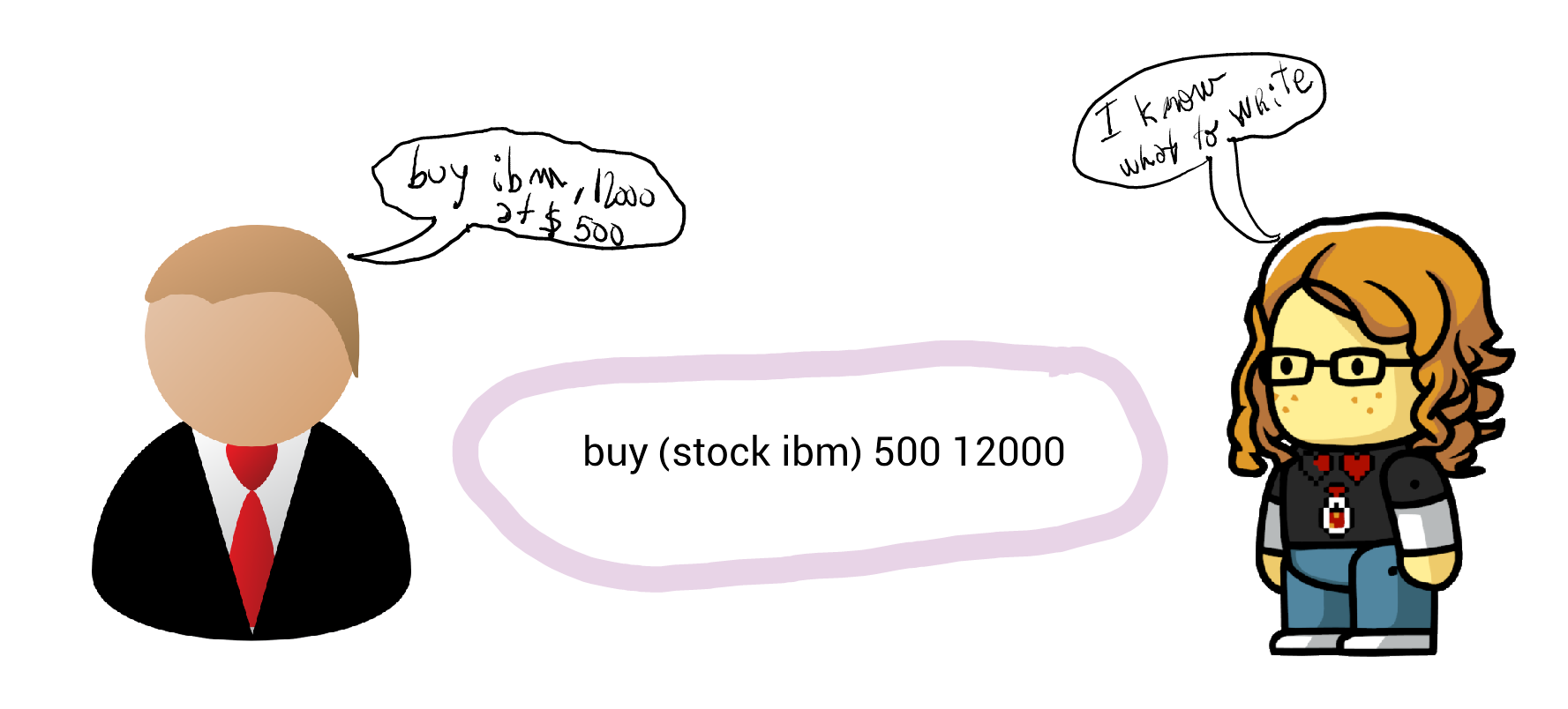
- It is the domain specific language (or DSL) which brings the gap between business users and developers.
EDSL vs. DSL
- What is the different between DSL and embedded DSL (or EDSL)?
- A domain specific language can be provided as stand alone.
- You write a compiler/interpreter for the DSL and provide all the tools to program with it
In contrast, an embedded DSL is written in a host language.
- It inherits the infrastructure (and programming language abstractions) of the host language.
- In this course, we use Haskell as the host language
We will leverage Haskell
- powerful type system,
- generic programming features,
- and tools
for programming our DSL.
- Many abstractions used in functional programming (e.g., monads) are known for being suitable to implement EDSLs. (We will see many examples along the course)
EDSL: Parts
EDSL Part Description Types Model a concept Constructors Construct the simplest elements of such types Combinators Build complex elements from simpler ones Run functions Observe the EDSL elements, possibly producing side-effects when doing so Let us get into a specific first in order to create a EDSL in Haskell.
Shapes: a simple EDSL for vectorial graphics
- Design a language to describe vectorial graphics.
- Made of some basic shapes.
- They scale without loosing definition.
- Ideal for logos.
- Take less space as pixel-based formats (e.g., BMP, JPEG, etc.)
Types and constructors
We want to model simple graphics
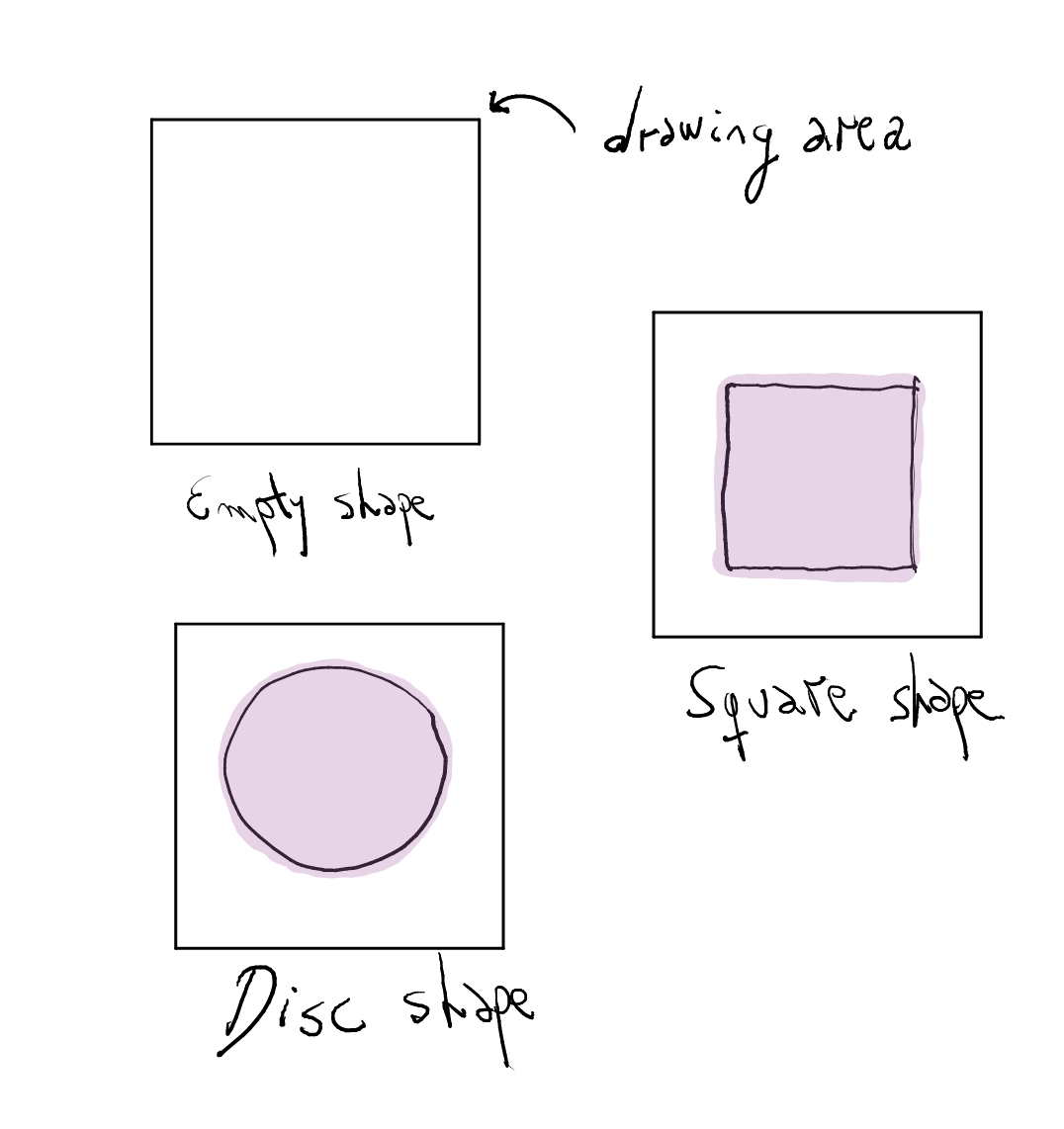
newtype Shape empty :: Shape disc :: Shape square :: Shape
Some basic combinators
Let us visualize some useful combinators
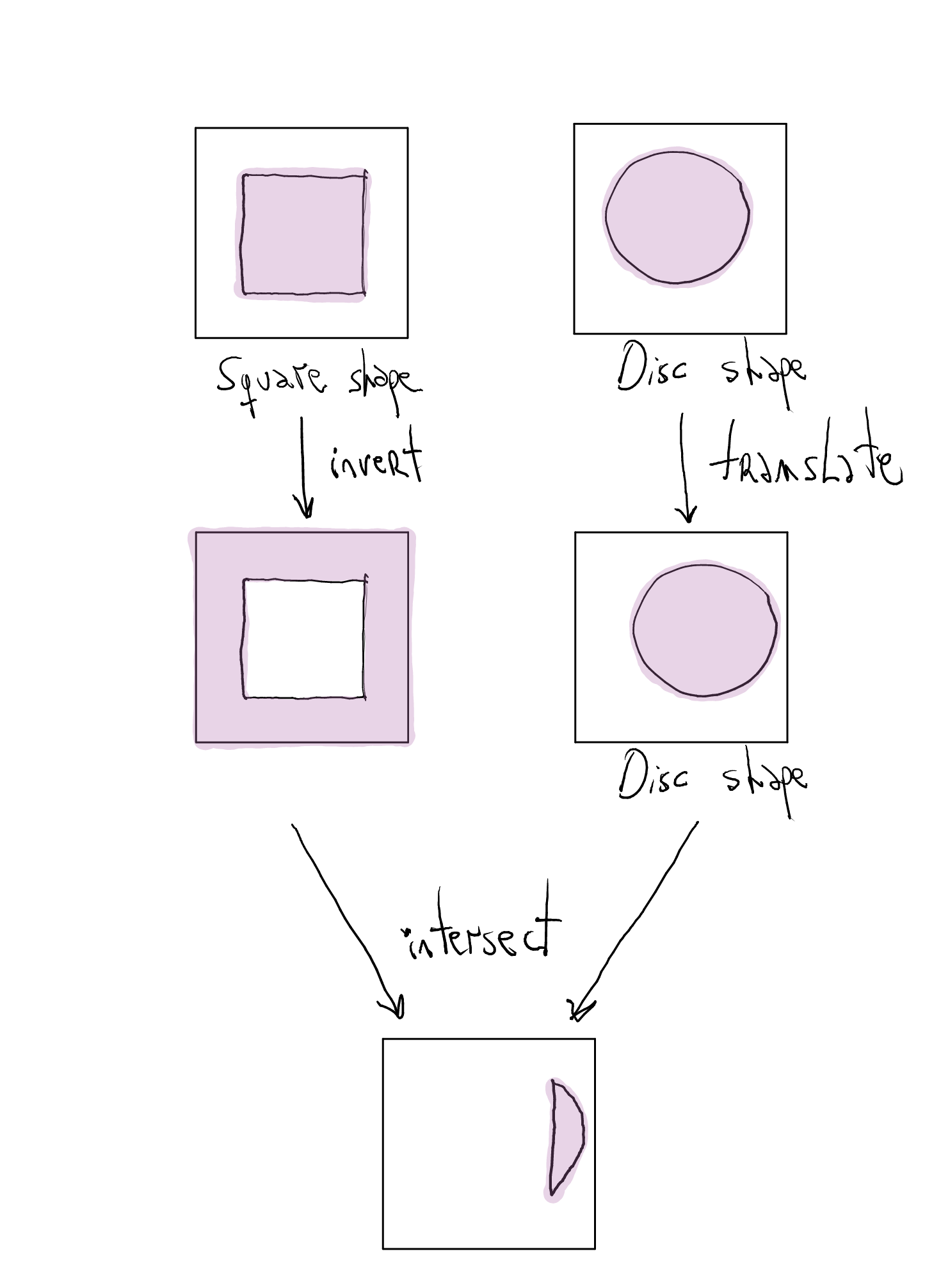
invert :: Shape -> Shape intersect :: Shape -> Shape -> Shape translate :: ?
What about
translate? We will move the figure based on a vector, i.e., on the x- and y-axes.invert :: Shape -> Shape intersect :: Shape -> Shape -> Shape translate :: Vec -> Shape -> Shape
A new type (Vec) has appeared in the interface!
A run (observation) function
A raster is going to render the image
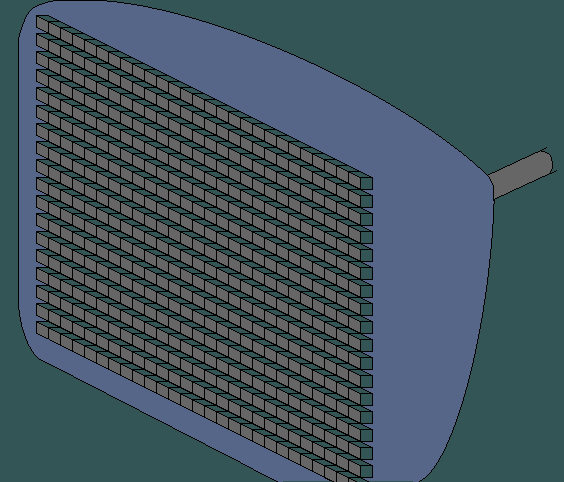
The raster is the one "observing" shapes and activating the corresponding pixels.
We assume the rater is composed of points (pixels if you wish)
inside :: Point -> Shape -> Bool
A new type (Point) has appeared in the interface!
Shapes: the interface
So far
newtype Shape empty :: Shape disc :: Shape square :: Shape invert :: Shape -> Shape intersect :: Shape -> Shape -> Shape translate :: Vec -> Shape -> Shape inside :: Point -> Shape -> Bool
Aspects to think when designing an API
- Compositionality: combining elements into more complex ones should be easy and natural.
- Abstraction: the user should not have to know (or be allowed to exploit) the underlying implementation of your types.
Classification of operations
- A primitive operation is defined exploiting the definitions of the involved types.
- A derived operation is defined purely in terms of other operations.
Implementation: shallow embedding
Types: represent elements by their semantics, i.e., what they mean. It is usually done by leveraging some abstractions of the host language.
data Vec = V { vecX, vecY :: Double }In this case, we leverage Haskell functions!type Point = Vec ptX = vecX ptY = vecY
newtype Shape = Shape (Point -> Bool)
Run functions: they are almost for free!
inside :: Point -> Shape -> Bool p `inside` Shape sh = sh p
Constructor functions and combinators do most of the work.
-- Constructors empty :: Shape empty = Shape $ \_ -> False disc :: Shape disc = Shape $ \p -> ptX p ^ 2 + ptY p ^ 2 <= 1 square :: Shape square = Shape $ \p -> abs (ptX p) <= 1 && abs (ptY p) <= 1
-- Combinators invert :: Shape -> Shape invert sh = Shape $ \p -> not (inside p sh) intersect :: Shape -> Shape -> Shape intersect sh1 sh2 = Shape $ \p -> inside p sh1 && inside p sh2
Translate deserves a bit of attention.Observe that if a picture is moved `n` units to the left, then the characteristic functions should be applied to `x - n` instead.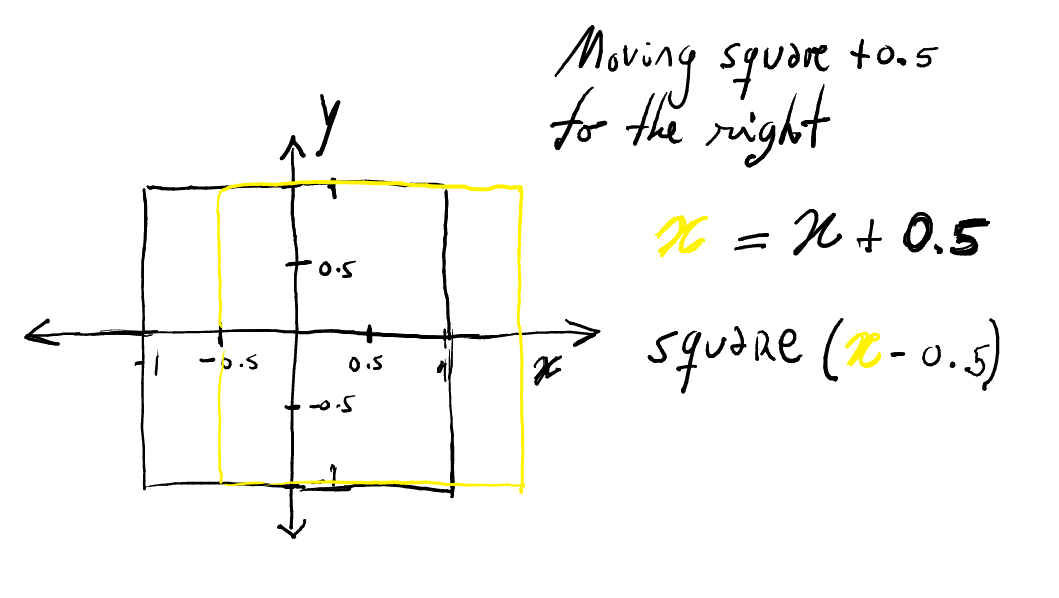
sub :: Point -> Vec -> Point sub (V x y) (V dx dy) = V (x - dx) (y - dy) translate :: Vec -> Shape -> Shape translate v sh = Shape $ \p -> inside (p `sub` v) sh
Transformation matrices
Basic idea

Let us see a concrete example: x-axis reflection

Observe that a point appearing in the "screen" depends if such point manipulated with some algebraic values appears in the considered shape.
We begin by introducing a new type for matrices and an inverse operation for them.
data Matrix = M Vec Vec inv :: Matrix -> Matrix inv (M (V a b) (V c d)) = matrix (d / k) (-b / k) (-c / k) (a / k) where k = a * d - b * c
Now the
transformoperationtransform :: Matrix -> Shape -> Shape transform m sh = Shape $ \p -> (inv_m `mul` p) `inside` sh where inv_m = inv m
Exercise: can you write the following derived operations?
-- reflects the shape on the x-axis x-reflection :: Shape -> Shape -- reflects the shape on the y-axis y-reflection :: Shape -> Shape -- Enlarge the shape by n% (n being the first argument) zoom_in :: Int -> Shape -> Shape
Shape rotation
Axes rotation (math revisited)

Which direction is the square shape rotated?
transform (m (pi/10)) square where m alpha = matrix (cos alpha) (sin alpha) (-(sin alpha)) (cos alpha)Clock-wise! Can you see why?
Points, Vectors, and Matrices in a separate module
The interface for shapes uses auxiliary mathematical abstractions
We define them in a different module (
Matrix.hs)
Alternative implementation : deep embedding
Types: represent how shapes are constructed (i.e., either by a basic shape or a combination of them).
data Shape where -- Constructor functions Empty :: Shape Disc :: Shape Square :: Shape -- Combinators Translate :: Vec -> Shape -> Shape Transform :: Matrix-> Shape -> Shape Intersect :: Shape -> Shape -> Shape Invert :: Shape -> Shape
Constructors and combinators: almost for free! Simply map them into the appropriated constructors in the data type.
empty :: Shape empty = Empty disc :: Shape disc = Disc square :: Shape square = Square transform :: Matrix -> Shape -> Shape transform = Transform translate :: Vec -> Shape -> Shape translate = Translate intersect :: Shape -> Shape -> Shape intersect = Intersect invert :: Shape -> Shape invert = Invert
Run (observation) function: all the work is here!
inside :: Point -> Shape -> Bool _p `inside` Empty = False p `inside` Disc = sqDistance p <= 1 p `inside` Square = maxnorm p <= 1 p `inside` Translate v sh = (p `sub` v) `inside` sh p `inside` Transform m sh = (inv m `mul` p) `inside` sh p `inside` Union sh1 sh2 = p `inside` sh1 || p `inside` sh2 p `inside` Intersect sh1 sh2 = p `inside` sh1 && p `inside` sh2 p `inside` Invert sh = not (p `inside` sh) -- * Helper functions sqDistance :: Point -> Double sqDistance p = x*x+y*y -- proper distance would use sqrt where x = ptX p y = ptY p maxnorm :: Point -> Double maxnorm p = max (abs x) (abs y) where x = ptX p y = ptY p
Shallow vs. Deep embedding
A shallow embedding (when it works out) is often more elegant and compact.
- Working out the type which provides the right semantics might be tricky.
A deep embedding is easier to extend.
- Adding new operations (by adding new constructors).
- Adding new run functions.
- Adding optimizations (e.g., by data type manipulation).
Most of the time you get a mixed between shallow and deep embedding.
In any case, abstraction is important!
module Shape.Shallow ( -- Types Shape -- abstract -- Constructor functions , empty, disc, square -- Primitive combinators , transform, translate , union, intersect, invert -- Run functions , inside ) where ...
The interface should not change based on a shallow or deep embedding implementation! No difference for the user of the EDSL!
Rendering a shape to ASCII-art
- A very interesting run function
It introduces the concept of windows
defaultWindow :: Window defaultWindow = Window { bottomLeft = point (-1.5) (-1.5) , topRight = point 1.5 1.5 , resolution = (40, 40) }- It has a dimension in terms of characters
- It has a dimension in terms of points
The render function essentially maps points to characters in a window.
-- | Generate a list of evenly spaces (n :: Int) points in an interval. samples :: Double -> Double -> Int -> [Double] -- | Generate the matrix of points corresponding to the pixels of a window. pixels :: Window -> [[Point]] -- | Render a shape in a given window. render :: Window -> Shape -> String render win sh = unlines $ map (concatMap putPixel) (pixels win) where putPixel p | p `inside` sh = "[]" | otherwise = " "- Function
unlinesandconcatMapare standard.
- Function
Discussion
- Adding colored shapes
- Discuss what you need to do
- Bad shallow implementations
- Looking at the render run function, we might decide to go for
newtype Shape = Shape (Window -> String)
- Discuss the problem with this implementation
- Looking at the render run function, we might decide to go for
- Other questions/comments?
Signal: Another EDSL
- We are interested to produce animated shapes.
- For that, we need to model how they might change based on time.
- We take inspiration from functional reactive programming approaches.
- We introduce the concept of
Signal, a value that changes over time. More specifically, we have the following initial API for our new EDSL.
-- Constructors constS :: a -> Signal a timeS :: Signal Time -- Combinators ($$) :: Signal (a -> b) -> Signal a -> Signal b -- Run function sample :: Signal a -> Time -> a
- Function
constSproduces a constant value, i.e., it does not change with time - Function
timeSreveals the current time, i.e., it is a signal which arrives at time T and produces the value T - Combinator
(SS)takes a functional signal and converts it into a function which changesSignal aintoSignal b - Run function
samplejust extracts the meaning of a signal
- Function
How do we program with it?
Let us try to get the next simple animation:
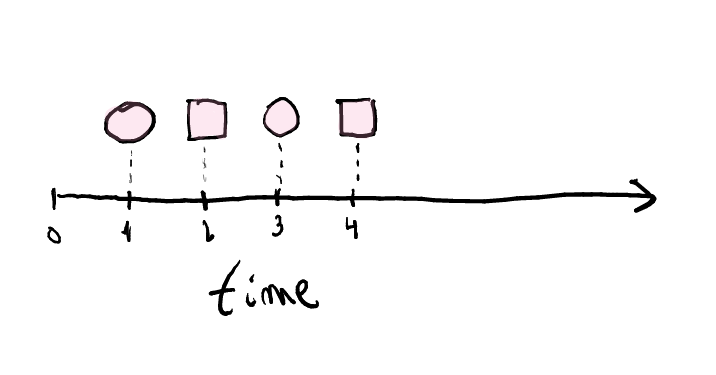
We write time-dependent functions which generate shapes
- A function for intermittently displaying two shapes
-- | It displays a shape on "odd times" and another one in "even times". change :: Shape -> Shape -> Time -> Shape change sh1 sh2 t | odd (floor t) = sh1 | otherwise = sh2
- A function for intermittently displaying two shapes
Convert them into signals
constS (change disc square) :: Signal (Time -> Shape)
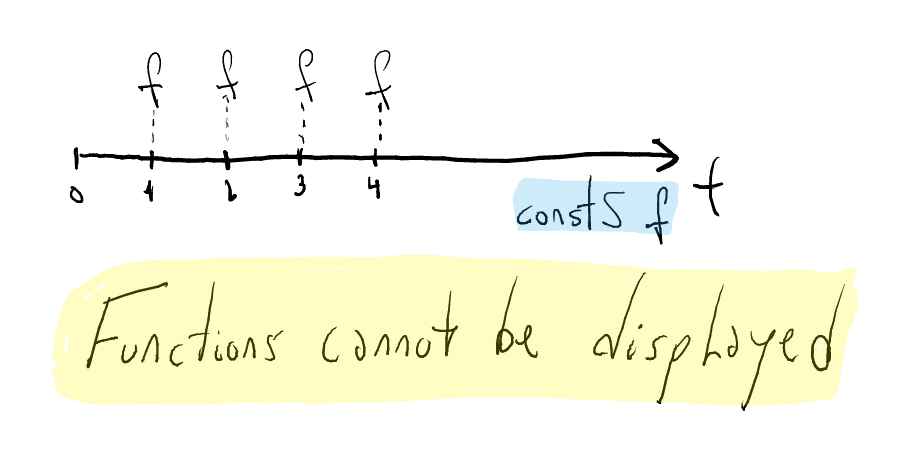
Convert the functional signal into a signal (corresponding to the image of the function) by applying time information. How do get time information? We use
timeS!constS (change disc square) $$ timeS
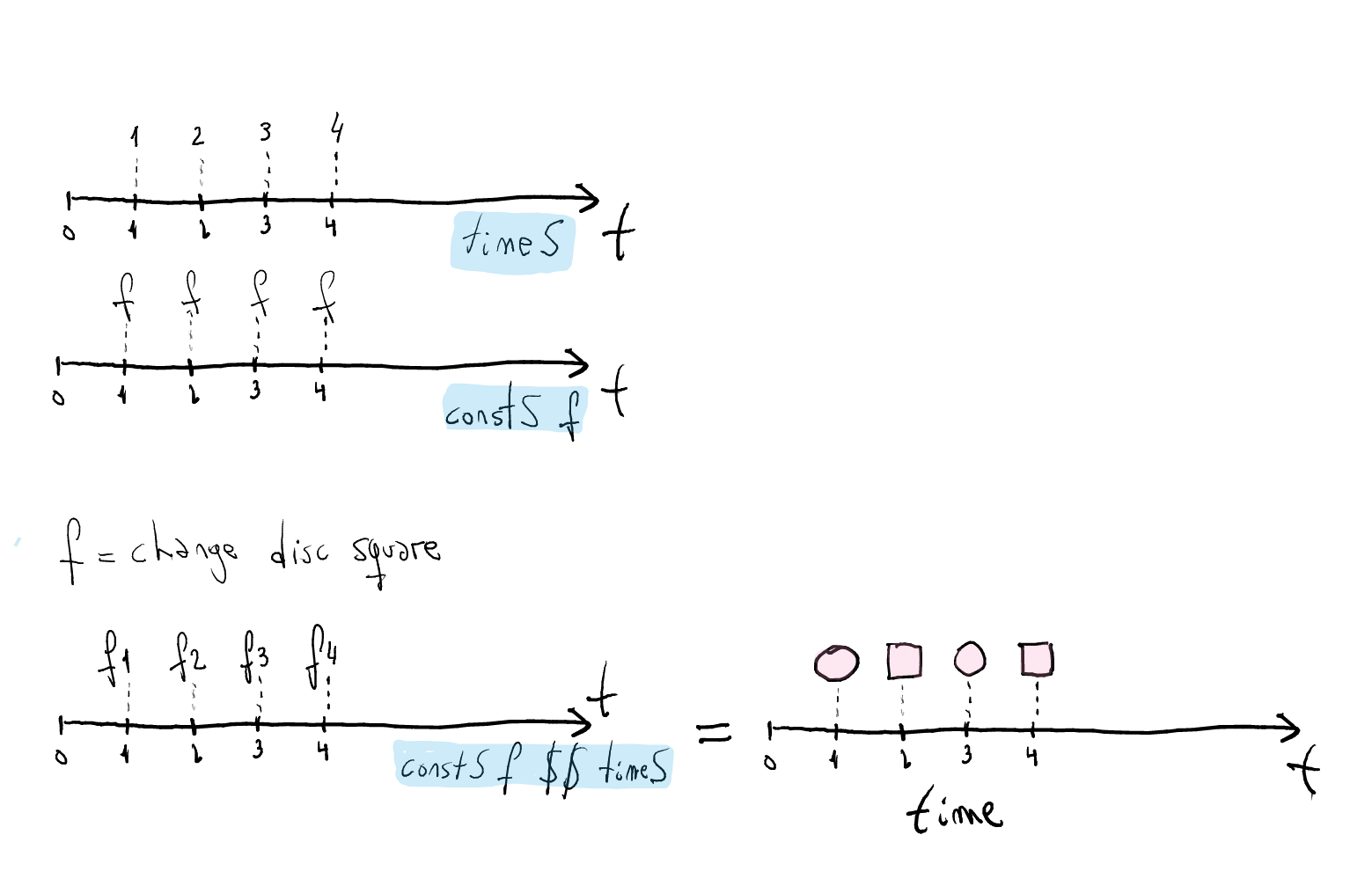
More operations
We will consider two more operations
-- Combinator mapT :: (Time -> Time) -> Signal a -> Signal a -- Derived operation mapS :: (a -> b) -> Signal a -> Signal b
Combinator
mapTallows to alter the mapping amongTimeandShapeto_zero :: Time -> Time to_zero = const 0 always_disc = mapT to_zero square_disc
- Exercise: write
mapSas a derived operation
Implementation: shallow embedding
We will model signals as Haskell functions of time
Time -> atype Time = Double newtype Signal a = Sig {unSig :: Time -> a} constS :: a -> Signal a constS x = Sig (const x) timeS :: Signal Time timeS = Sig id ($$) :: Signal (a -> b) -> Signal a -> Signal b fs $$ xs = Sig (\t -> unSig fs t (unSig xs t)) mapT :: (Time -> Time) -> Signal a -> Signal a mapT f xs = Sig (unSig xs . f) sample :: Signal a -> Time -> a sample = unSigImplementation: deep embedding
type Time = Double data Signal a where ConstS :: a -> Signal a TimeS :: Signal Time MapT :: (Time -> Time) -> Signal a -> Signal a (:$$) :: Signal (a -> b) -> Signal a -> Signal b constS = ConstS timeS = TimeS ...
The run function generates the functions of type
Time -> a(most of the work is here!)-- | Sampling a signal at a given time point. sample (ConstS x) = const x sample TimeS = id sample (f :$$ s) = \t -> sample f t $ sample s t sample (MapT f s) = sample s . f
Go live!
Summary
- Different kind of operations
- Constructors, combinators, and run functions
- Primive or derived operations
- Implementation styles
- Shallow embedding: representation given by semantics
- Deep embedding: representation given by operations
- Remember
- Compositionality
- Abstraction